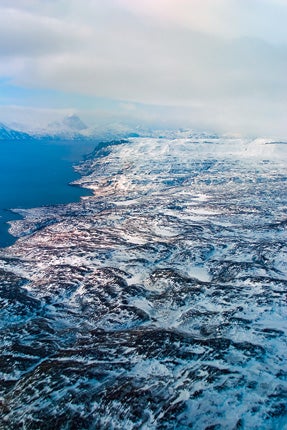 THE LIFE OF A FERRY PILOT. Punctuated by fun moments, ferry flying is characterized by hard work and long flying legs. |
I receive more e-mail and snail mail from readers about ferry flying than on all other subjects combined. It seems every time I write an account of flying the Atlantic or Pacific, the e-mails come flooding in. I answer every one of them, but most of the communications from readers are written in the same vein: How do I become a ferry pilot?
The reality is, most of the time, you don't. There are three primary reasons why international delivery flying isn't a viable occupation these days.
1) The number of airplanes available for delivery has dropped dramatically in the last 20 years. The state of the economy obviously has a direct bearing on the number of new and used airplanes delivered overseas (used plane sales may be slightly more impervious to the economy).
The United States is by far the world's primary producer of general aviation airplanes, and approximately 50% of everything built here is exported each year. In 1977, when I began delivering to Europe, the United States produced some 17,000 units. Last year, total production was just above 3,000 airplanes. The math should speak for itself.
2) Insurance companies now control the world. Most ferry policies are underwritten by Lloyd's of London, and it sets the rules for pilots trying to break into the field. Requirements usually are at least a commercial/multi/instrument rating with 1,000 hours of total time, a minimum of 25 to 100 hours in type (depending upon model) and the appropriate route qualification.
Route and type requirements are perfect examples of the old catch-22. You can't get experience until you have experience. Unlike the bad old days when insurance demands were vague or nonexistent, today's hull values are so high and the premiums are often so exorbitant that ferry companies can't afford to use any but the most qualified pilots.
The type requirement alone is enough to stop some pilots cold. By the time many pilots accumulate 500 hours, they've usually flown a half-dozen types.
Twin time is especially difficult to come by, and turbine hours are almost impossible to amass unless you know someone who owns a turboprop or jet.
When I started ferrying in 1977, I was fortunate in that writing pilot reports for Plane & Pilot and other magazines guaranteed that my flight hours were spread over at least 100 types of aircraft (now up to 305). This meant I could usually qualify for most of the types I was asked to fly.
3) In 1977, there were many companies in the ferry business, and I flew part-time for one of the largest, Globe Aero of Lakeland, Fla. I left Globe in 1990 and now operate my own company, Bear Air International (which consists mostly of just me). Today, there are only a handful of companies in the ferry business, and the number of experienced aviators with type and route qualifications far outstrips the need for new pilots.
I hear from pilots all the time who imagine that ferry flying must be the most glamorous of time-builders toward the magic 1,500-hour ATP level often demanded by the airlines. Yes, you can build time in a hurry if there are airplanes available to ferry and you can somehow become qualified to fly them, but there's rarely anything glamorous about the job. You're sometimes flying with temporary HF radios occupying the right seat---assuming you still have a right seat (it's often replaced by a ferry tank). You usually can't carry passengers even if you want to, as the airplane may be tanked with ferry fuel and operating under a special airworthiness certificate that allows "essential crew only." Not very glamorous.
If you think about it, the reasons for the limitations are obvious. We're often operating 1,000 pounds or more over gross, not the greatest fun you can have in a little airplane. Because the goal is to make a profit, not have an if-it's-Thursday-this-must-be-Paris vacation, our airplanes usually carry enough fuel for 15 to 20 hours of endurance, and we often fly the longest legs possible, usually into the cheapest destinations. These are places where fuel, hotels and landing fees are the lowest. They tend not to be the destinations most pilots envision.
On a ferry to Australia, for example, Hawaii is a guaranteed stop, but we usually fly into Hilo rather than Honolulu (it's cheaper). Then, it's on to Majuro in the Marshall Islands in turbine equipment (no avgas available) or Christmas Island, Kiribati, in pistons. After that, it's usually on to Pago Pago, American Samoa, or Honiara, Solomon Islands---neither is known as a hot spot for glamour and night life. After that, it's on to Noumea on the eastern route; Brisbane on the more direct western route.
Flying the Atlantic, we ideally go into truly unglamorous Goose Bay, Labrador; then on to Narsarsuaq, Greenland; Reykjavik, Iceland---admittedly one of the nicer stops---and Wick, Scotland (no reason you should have heard of it, but it's inexpensive). We'll often spend many extra days on the North Atlantic route waiting for weather, since it's sometimes simply unflyable for little guys at low altitude. That's especially the case in spring and fall, when icing is the worst. When we do fly, we do so to the least expensive airports we can find, often arriving after the hotel restaurant has closed and leaving the next morning before it opens.
We're not allowed the privilege of taking extra days off en route on most trips. When you're delivering a buyer's $1 million Malibu or Baron, much less a $2 million Caravan or Meridian, chances are the buyer won't be too happy if you take a couple of extra days off in Reykjavik to visit the Blue Lagoon.
True, we may have the option of staying a few extra nights at our destination (on our own nickel, of course), but that destination may not be all that exciting. On Paris trips, for example, we usually deliver to Toussus-le-Noble Airport, which is halfway between Paris and Versailles, and 30 miles from anywhere. Flying to Japan, we never deliver to Narita (Tokyo)---way too expensive. Instead, we go into Sendai, which is 200 miles north. Profit rules.
If you want to make money in the ferry business, then you jump the first flight home (riding in coach, naturally), which is often in the middle of the night and includes two stops and plane changes to get the lowest fare.
Aw gee, Bill, that all sounds really tough, flying million-dollar airplanes overseas. No, it isn't always. None of this is to suggest there aren't some rewards to ferry flying. In 201 international trips so far, I've been paid to visit probably 60 countries in the last 32 years. Too often, however, all I've seen has been the local airport and the road back and forth to the hotel. Most of the time, ferry flights are days and days of hard work punctuated by brief moments of fun. And, yes, the view from on high has often been worth it. Just don't call it glamorous.
Bill Cox is in his third decade as a senior contributor to Plane & Pilot. He provides consulting for media, entertainment and aviation concerns worldwide. E-mail him at flybillcox@aol.com.

Subscribe to Our Newsletter
Get the latest Plane & Pilot Magazine stories delivered directly to your inbox






